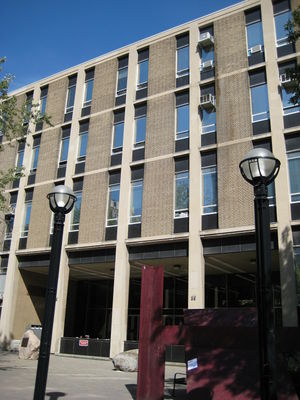Galbraith Building
The Galbraith Building, located on 35 St. George Street, was completed in 1960 as the Faculty of Applied Science and Engineering experienced a period of rapid expansion from the late 1940s to 1950s. It was constructed at a cost of $7 million, and was designed by Page and Steele architects (who later redesigned the interior of the Sandford Fleming Building after it was destroyed by a fire). It currently houses many of the Faculty's main operations, including the Registrar's Office, the First Year Office, and the Civil Engineering Department.
| Galbraith Building | |
|---|---|
 | |
| Location | 35 St. George Street |
| Year Constructed | 1960 |
| Major Offices/Labs | |
| Department of Civil Engineering | |
| Office of the Registrar | |
| First Year Office | |
| Engineering Outreach & Admissions Office | |
| Michael E. Charles Faculty Council Chamber | |
| Mark Huggins Structures Lab | |
Departments and Offices
- Office of the Registrar (GB157)
- Admissions Office (GB153)
- First Year Office (GB170)
- Student Recruitment and Outreach Office (GB173)
- Math Help Office
- Office of Advancement, Alumni Relations (GB116)
- Department of Civil Engineering (GB105)
- Michael E. Charles Faculty Council Chamber (GB202)
Notable Laboratories
Structure
History
The Galbraith Building was officially opened on the seventh of March 1961 by the Honourable J. Keiller Mackay, Lieutenant Governor of Ontario. The building was created to provide for the teaching of Civil Engineering, Electrical Engineering, and Aeronautical Engineering. It also contains the Dean's Office, the Faculty Office, the Council Room, and Common Rooms for the staff and students.
To mark the occasion of the opening of the Building, a special convocation was held on the preceding evening, at which the honorary degree of Doctor of Laws was conferred on William Percy Dobson, Henri Gaudefroy, Paul Gray Hoffman, John Hamilton Parkin and John Bertram Stirling. Dr. Hoffman gave the address to Convocation. As part of the opening day ceremonies, three scientific lectures were given by distinguished engineers.
The Galbraith Building was constructed as part of the University of Toronto's expansion program in the late 1950s and early 1960s. The university underwent an unprecedented growth during this period, which also saw the construction of the Margaret Addison Residence, the Dental Building, Loretto College, Benson Building, Sidney Smith Hall, Edward Johnson Building, and the Victoria College Library, among others.
It was evident to the Faculty of Applied Science and Engineering for many years that a new building would be required to accommodate the growing number of students and Faculty members. As early as 1910, the Dean had appealed for new space and the replacement of the old Engineering Building ("The Little Red Skulehouse" as it came to be known). However, construction of a new dedicated building for engineering would be stalled by surrounding developments as well as the two World Wars.
It was not until the late 1950s that a new building was approved by the Board of Governors. In the meantime, the Department of Civil Engineering had grown too large for the original Engineering Building, and was forced to share space with the Department of Electrical Engineering in the Electrical Building (now the Rosebrugh Building), which has been described as "prison-like" by Faculty of the time.
To facilitate the construction of the Galbraith Building, the old Forestry Building (now known as the Physical Geography Building) was physically moved from its location just north of the Wallberg Building to its current location just west of Convocation Hall. It was lifted from its foundations by a series of jacks, and moved with rollers on a set of rails by manual labour at a rate of several inches per day.
Ground was broken in 1959 for the Galbraith Building, which was designed by the architectural firm Page and Steele, and constructed by the contractors The Foundation Company. The building was ready for limited occupancy by the opening term in September of 1960, despite a 5-month long steelworker strike] in the U.S. which affected construction across the continent.
It is said that the original barrel of the Skule Cannon Mark II was laid into the cornerstone of the Galbraith Building.
References
- University of Toronto. Galbraith Building: Opening Ceremonies. University of Toronto Press, 1961.
- White, Richard. The Skule Story. University of Toronto Press, 2000.
- University of Toronto Engineering Society. Skule Yearbook. 1959.